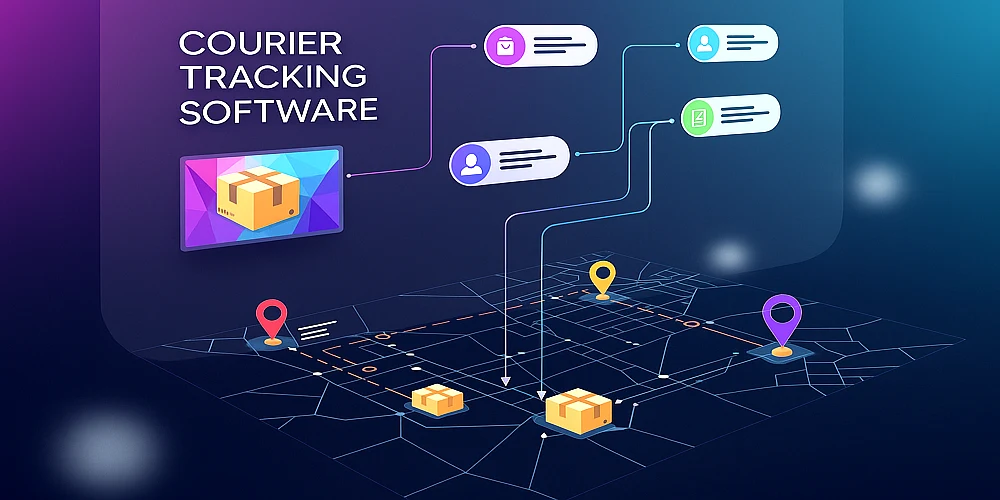How to Choose the Best Courier Tracking Software for Your eCommerce Business
In today’s competitive eCommerce world, customer expectations are higher than ever. Buyers want fast shipping, accurate delivery updates and full visibility from the moment they place an order until it reaches their doorstep. If your business can’t deliver that experience, your customers may go elsewhere.
That’s where courier tracking software comes in.
This guide will help you understand what courier tracking software does, why it matters, and how to choose the right solution for your growing online business.
Why Tracking Software Is Essential in eCommerce
Courier tracking isn’t just a technical upgrade, it is a must-have for any business that ships products. Here’s why it matters:
When used properly, tracking software becomes an extension of your customer service and a competitive advantage.
Key Features & Benefits of Courier Tracking Software
Selecting the right courier tracking software is essential for eCommerce businesses. The right features not only streamline operations but also enhance customer satisfaction and build trust. Here are the key capabilities and how they benefit your business:
Real Time Shipment Tracking
Track packages from dispatch to delivery, giving both your team and customers full visibility.
Benefit: Increases transparency, reduces “Where is my order?” inquiries, and builds customer confidence.
Automated Notifications
Send customizable alerts like “out for delivery” or “delivered” via email or SMS.
Benefit: Minimizes repetitive support calls, keeps customers informed, and improves overall satisfaction.
Proof of Delivery (POD)
Capture digital signatures, timestamps, and photos to confirm successful deliveries.
Benefit: Prevents delivery disputes, ensures accountability, and strengthens trust in your service.
Branded Tracking Pages
Maintain brand consistency with tracking pages customized with your logo, colors, and messaging.
Benefit: Keeps customers on your platform, reinforces brand identity, and improves the user experience.
Order and Platform Integration
Capture digital signatures, timestamps, and photos tSeamlessly connect the tracking software with your eCommerce platform, inventory system, or CRM.
Benefit: Reduces errors, saves time, and ensures all orders and customer data are accurately synced.
Route Planning & Optimization
Optimize delivery routes for in-house shipments to save time, fuel, and increase driver productivity.
Benefit: Enhances operational efficiency and ensures timely deliveries, even during peak periods.
Analytics & Delivery Reports
Access detailed reports on delivery performance, delays, failed attempts, and customer satisfaction.
Benefit: Provides actionable insights to optimize routes, improve delivery reliability, and boost overall efficiency.
What Makes Good Courier Tracking Software?
Before investing in any tool, it’s important to understand the key features that truly make a difference. Here are the essential capabilities to look for:
Real-Time Shipment Visibility
Your software should show exactly where a package is, when it was scanned last, and when it’s estimated to arrive. Real-time visibility helps both your customers and your team stay informed.
Automated Notifications
Automatic alerts like “out for delivery” or “delivered”, help to manage expectations and reduce unnecessary support calls. These notifications should be customizable and sent through email or SMS.
Proof of Delivery (POD)
Digital signatures, time stamps and photo evidence offer clear confirmation that a package was successfully delivered. This helps avoid disputes and increases accountability.
Branded Tracking Pages
A professional tracking page with your logo, colors, and messaging builds brand consistency. It also keeps customers on your website instead of redirecting them to third-party courier sites.
Order Integration
Your tracking software should easily connect with your online store. This means automatic linking of order numbers, customer information, and shipment status. This saves time and reduces human error.
Route Planning and Optimization
If you handle deliveries yourself, smart route planning can reduce fuel use, speed up delivery times and make drivers more productive.
Analytics and Delivery Reports
Insightful reporting allows you to track delivery performance, identify common delays, and measure key metrics like average delivery time, failed attempts, and customer satisfaction.
Mistakes to Avoid When Choosing Tracking Software
Selecting the right courier tracking software can significantly impact your business operations and customer satisfaction. However, many eCommerce businesses make common errors that can lead to inefficiencies or wasted investment. Here are key mistakes to avoid:
Ignoring Integration Needs
Choosing software that does not seamlessly connect with your eCommerce platform, warehouse system, or CRM can cause errors, duplicate entries, and operational delays.
Overlooking Scalability
Selecting a tool suitable only for your current order volume may result in costly migrations as your business grows. Always ensure the software can scale with your expansion.
Neglecting Customer Experience
Focusing only on internal tracking features without considering branded tracking pages, notifications, and user-friendly dashboards can frustrate customers.
Skipping Security Checks
Failing to review encryption, access control, and data compliance can risk sensitive customer information and hurt your brand’s credibility.
Underestimating Support Needs
Choosing a provider with limited or slow customer support may leave your team stranded during high-volume periods or technical issues.
Overpaying for Unnecessary Features
Advanced functions may sound appealing, but paying for features you would not use adds unnecessary costs. Start with essentials and upgrade as needed.
Avoiding these mistakes ensures you select courier tracking software that is efficient, secure, scalable, and aligned with both your business needs and your customers’ expectations.
Integration with eCommerce Platforms
Courier tracking software should seamlessly integrate with popular eCommerce platforms like Shopify, WooCommerce, Magento, etc. This ensures automatic syncing of orders, customer data, and shipment status, reducing errors and saving time.
Proper integration also allows automated notifications and a consistent branded experience, helping improve operational efficiency and customer trust.
How to Choose the Right Courier Tracking Software
Not all tracking solutions are created equal. The best one for your business depends on several factors. Here’s a step-by-step approach to selecting the right software:

Step 1: Understand Your Delivery Workflow
Start by mapping out your current shipping process. Ask yourself:
Your answers will help narrow down your needs.
Step 2: Prioritize Features That Solve Your Pain Points
Focus on the features that will have the most impact. If customers complain about late deliveries, prioritize live tracking. If your team spends hours sending updates, look for automation tools.
Don’t pay for advanced features you won’t use yet. Start with the essentials and upgrade later as your business grows.
Step 3: Make Sure It Fits Your Platform
The software you choose must integrate smoothly with your eCommerce platform, whether that’s Shopify, WooCommerce, Magento, or a custom system. Without direct integration, you’ll face syncing errors and data entry headaches.
Also, check if it can connect with your warehouse, inventory, or customer support tools. A connected system reduces duplication and improves accuracy.
Step 4: Check for Scalability
Your business may be small today, but what about next year? Choose tracking software that can scale as you grow. Look for flexible pricing, support for more shipments, and the ability to add new features or couriers over time.
A system that grows with you avoids the need for costly migrations in the future.
Step 5: Review Security and Compliance
You’ll be handling customer addresses, phone numbers, and delivery data. That makes data protection critical. Look for a provider that offers:
Strong security builds trust and prevents data breaches.
Step 6: Test the User Experience
Before committing, test how easy the software is to use, for both your team and your customers. A clean dashboard, simple setup, and intuitive tracking page can save hours of training and frustration.
Also, test how quickly it updates tracking data, how accurate the ETAs are, and whether notifications are sent promptly.
Step 7: Consider Customer Support
Software issues happen, even with the best systems. You’ll want to know there’s helpful, responsive support when you need it. Check if the provider offers:
Don’t underestimate the value of good support during the busy shipping season.

Why This Matters for Your Brand
At the end of the day, delivery is the final touchpoint in your customer’s shopping journey. A delayed package, missed update, or unclear tracking status can turn a satisfied buyer into a lost customer.
On the other hand, fast, accurate delivery updates build confidence. They show that your business is organized, reliable, and committed to customer satisfaction.
The right courier tracking software helps you deliver that experience every time.

Conclusion
Choosing courier tracking software is not just a technical decision. It is a customer experience decision. The right platform keeps your team informed, your customers happy, and your operations running smoothly. By focusing on your specific needs, essential features, system compatibility, scalability, and support quality, you will be better positioned to deliver reliable, transparent shipping that builds long-term customer trust.
For businesses and individuals in India, TPC, the pro premium tracking offers a trusted solution with real-time updates, wide coverage, and user-friendly access through its website and app.